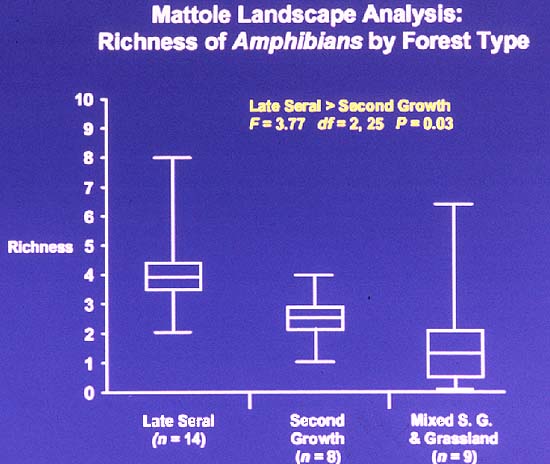 |
Bibliography | Background | Hypotheses | Home |
 |
Bibliography | Background | Hypotheses | Home |
![]()

Source: H. Welsh, U.S.F.S. - PSW Redwood Sciences Lab, Arcata,
CA
This graph shows that late seral forests (old growth) contain significantly more amphibian species than either second growth or mixed second growth and grassland. At half the 14 sites in late seral forests, an average of three and a half to four and a half species were found. In second growth, half of the 8 sites had between two and three species, while in mixed second growth and grassland, half the 9 sites had an average of about one half to two species. Data is from research conducted by the herpetology group at the USFS Redwood Sciences Lab which is awaiting publication.
![]()
Graphs and photographs from Dr. H. H. Welsh, Redwood Sciences Lab
From the Mattole River Basin:
Richness of amphibian species in 3 forest cover types (47 KB)
Air temperatures vs. distance from stream for three forest types (45 KB)
Abundance of Black Salamanders in perennial and intermittent streams (40 KB)
| Examples of the three forest cover types in the Mattole River basin: | ||
| Late seral | Second growth | Second growth and grassland mixed |
From regional studies:
Number of tailed frogs plotted against age of forest and air temperature (45 KB)
Abundance of So. torrent Salamander vs. % canopy (35 KB)
![]()
|
Table of Contents for Background Pages |
|||||
| Stream Conditions: | Water Quality | Sediment | Riparian | Big Wood | Habitat Types |
| Watershed Conditions: | Vegetation Types | Slope Stability | Roads & Erosion | Cumulative Impacts | Urbanization |
| Fish & Aquatic Life: | Fish Populations | Amphibians | Aquatic Insects | Hatcheries | Fish Disease |
| Restoration: | Stream Clearance | In-stream Structures | Riparian | Watershed | Strategy |
| Geology / Hydrology: | Geology | Soils | Precipitation | Stream Flow | Channel Processes |
| Policy & Regulation | ESA | TMDL | Forest Rules | 1603 Permits | Water Rights |
| www.krisweb.com |